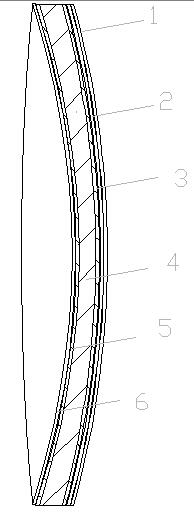Discoloring process of resin lens
A resin lens and process technology, applied in the field of discoloration, can solve the problems of poor durability of film layer discoloration, difficult control of lens quality, complicated production process, etc., to achieve the effects of easy control, long service life and simple process
- Summary
- Abstract
- Description
- Claims
- Application Information
AI Technical Summary
Problems solved by technology
Method used
Image
Examples
Embodiment 1
[0032] Such as figure 1 Shown is the structural diagram of the photochromic resin lens.
[0033] Color-changing resin lens comprises resin lens 4; Eyeglass front surface color-changing layer 3; The front surface, the front surface hardening layer 2 is attached to the surface of the lens front surface color change layer 3; the rear surface hardening layer 5 is attached to the rear surface of the resin lens 4; the front and rear surface coating layers 1, 6 are attached The surfaces of the corresponding front and rear hardening layers 2 and 5.
[0034] The resin lens 2 includes CR-39 Columbia resin, IPP, light stabilizer, dye and anti-UV additive; the color-changing layer 3 is a photochromic monomer dissolved in a color-changing hardening liquid. The coating layers 1 and 6 on the front and rear surfaces are multi-layer anti-reflection films and super waterproof films.
[0035] The photochromic lens is mainly realized through the following processes:
[0036] 1. After the cur...
Embodiment 2
[0048] Such as figure 1 Shown is the structural diagram of the photochromic resin lens.
[0049] Color-changing resin lens comprises resin lens 4; Eyeglass front surface color-changing layer 3; The front surface, the front surface hardening layer 2 is attached to the surface of the lens front surface discoloration layer 3; the rear surface hardening layer 5 is attached to the rear surface of the resin lens 4; the front and rear surface coating layers 1 and 6 are attached The surfaces of the corresponding front and rear hardening layers 2 and 5.
[0050] The resin monomer 2 includes MR series polyurethane-based monomers, MR series polyisocyanates, light stabilizers, dyes and anti-UV additives; the color-changing layer 3 is a photochromic monomer dissolved in a color-changing hardening solution. The coating layers 1 and 6 on the front and rear surfaces are multi-layer anti-reflection films and super waterproof films.
[0051] The photochromic lens is mainly realized through ...
PUM
| Property | Measurement | Unit |
|---|---|---|
| particle size | aaaaa | aaaaa |
| diameter | aaaaa | aaaaa |
Abstract
Description
Claims
Application Information
 Login to View More
Login to View More - R&D
- Intellectual Property
- Life Sciences
- Materials
- Tech Scout
- Unparalleled Data Quality
- Higher Quality Content
- 60% Fewer Hallucinations
Browse by: Latest US Patents, China's latest patents, Technical Efficacy Thesaurus, Application Domain, Technology Topic, Popular Technical Reports.
© 2025 PatSnap. All rights reserved.Legal|Privacy policy|Modern Slavery Act Transparency Statement|Sitemap|About US| Contact US: help@patsnap.com

